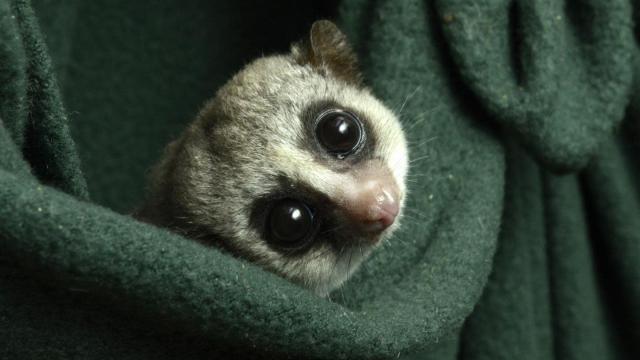Scientists at the Duke Lemur Centre in North Carolina say their fat-tailed dwarf lemurs went into hibernation for the first time ever in captivity last winter, mimicking the process their counterparts in the wild undergo regularly. By studying this process up close in our primate relative, the researchers also hope to better understand the human body and how it can be safely slowed down during times of need, such as during certain medical procedures.
Fat-tailed dwarf lemurs (Cheirogaleus medius), like all other species of lemurs, are native to Madagascar. In the wild, they bulk up on food during the summer, then hibernate anywhere from three to seven months. This means their body temperature drops sharply, as does their metabolism (like other hibernators, though, they might have brief periods of activity and even sleep). That makes these primates, which are distinct from monkeys and apes, our closest relatives known to engage in hibernation.
In captivity, though, the lemurs are much more active at all times of the year. During the winter, they may experience torpor — a short-term period of dormancy — for a day at a time, but not anything like the extended hibernation they go through in the wild. The lemur population at the Duke Lemur Centre has been captive for at least four generations, since the 1960s, and it seemed possible they had lost the ability to hibernate. But the researchers theorised that their lemurs could still go into hibernation, so long as their living conditions were made to more closely resemble what they would experience in the wild.
Their findings, published in Scientific Reports last week, seem to show that they were right. The team included eight lemurs in their experiment, the bulk of which took place between October 2019 and February 2020. Throughout the year, they slowly adjusted the lights in their living space to mimic the longer summer days and fed the lemurs more generously.
Once fall arrived, the lemurs were moved into fake tree hollows inside a temperature-controlled space where they could see and smell each other but were physically isolated. Then they turned down the lights and temperature over time. This meant 9.5 hours of light during the shortest days, rather than the 14.5 hours seen at peak summer, while the temperature dropped from 77 degrees Fahrenheit to a range of 50 to 59 degrees Fahrenheit. The lemurs were offered a typical zoo diet at first, but once the rooms got chillier, they were only given food for every 24 hours of wakeful activity.
By February, the lemurs had spent about 70% of their time on average in torpor. At their hibernating peak, the lemurs spent up to 11 days nearly motionless. Unlike their wild counterparts, they did still sometimes move around and eat occasionally. After the experiment was over, the lemurs had lost around 22% to 35% of their body weight, but they otherwise seemed healthy.
“They did not disappoint,” said lead author Marina Blanco in a statement released by the Centre. “Indeed, our dwarf lemurs hibernated just like their wild kin do in western Madagascar.”
It’s possible that reawakening these lemurs’ hibernation power will be better for them in the long run. The authors note that hibernation may very well account for their relatively longer life spans compared to other similarly sized animals (the oldest known lemur, also from the Duke Lemur Centre, died at age 29). And while the lemurs at the centre do appear to be healthy for the most part, the authors speculate that the lack of hibernating could contribute to health problems like excess weight, diabetes, and cataracts in some of their oldest lemurs.
Allowing the lemurs to hibernate regularly might “help maintain a healthy dwarf lemur population in captivity, if hibernation is expressed in moderation,” the team wrote.
[referenced id=”1045203″ url=”https://gizmodo.com.au/2017/06/hibernating-aliens-could-explain-the-great-silence/” thumb=”https://gizmodo.com.au/wp-content/uploads/2017/06/01/pkmqwbiavbv0ayyxut0b-300×169.jpg” title=”Hibernating Aliens Could Explain The Great Silence” excerpt=”We have yet to find any traces of extraterrestrial intelligence, a vexing problem known as the Fermi Paradox. A new solution to the “where are all the aliens?” conundrum suggests that advanced aliens do exist — but they’re in a self-imposed state of hibernation, waiting for a future era of…”]
Studying the ins-and-outs of lemur hibernation in a controlled setting might also benefit humans. Scientists have long wanted to understand hibernation better and how it could be safely replicated in people. Everything from emergency surgeries to space travel could be made easier if people could hibernate at a moment’s notice and wake up later without harm. And because this process deeply involves our metabolism, figuring it out might also give us insights into metabolic disorders like diabetes or even the very nature of ageing.
The researchers plan to keep studying hibernation in their lemurs by using more extensive but non-invasive monitoring methods, including learning how their bodies can withstand spikes in sugar and fat metabolism without damage.
